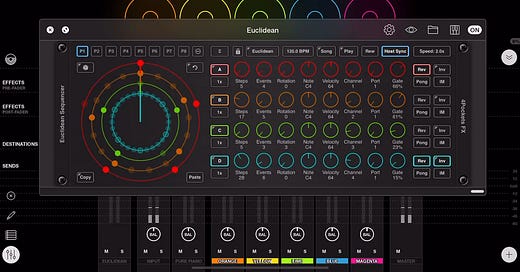A lot has been going on this week, it’s been a busy one and there is a lot going on in the online world and music software world, which is great for me, lots of stuff to try out!
Oh, have you heard what Substack have been up to? No? Where the heck have you been all of this time then?
I’m of course talking about Notes, which I think is brilliant and a game changer not just for Substack but will have a broader reaching influence across the web. I hope to see you on there, as I will be using it to talk about music and photography - check out
and two of my photography projects. I believe every time I publish a post it will surface on Notes anyway...Let’s move on to today’s post, I started writing this ages ago and it’s been sat in my drafts for ages
Anyway, have you ever heard of Euclidean? In the video I talk more about the sequencer of the same name and how useful it can be for composing repeating rythyms and melodies. I didn’t go into much detail on the background though, so here is a little history lesson.
Mathematics and music are closely connected in more ways than you might know. Scales are all maths when it boils down to it but you can also apply equations to timing and the division of notes to create interesting melodies. Euclidean sequencers have been a part of modular synthesis for quite some time, as I will explain shortly.
Euclid was an ancient greek mathematician and was considered to be the founding father of geometry. It was his early work in geometry that later led to the exploration of how the theory could be applied to music.
Euclidean rhythms were first explored by Godfried Toussaint (I got the name embarrassingly wrong in my video) in 2004. Euclidean rhythms have their roots in Greek mathematician Euclid’s algorithm and involve using the greatest common divisor of two numbers to place hits in a sequence as evenly as possible across a set timing division.
In practice this is actually simpler than you might think - simply set a number of steps for your sequence and a number of events to generate rhythmic pattern. How evenly spaced the resulting pattern is will depend on how neatly the step length divides by the number of events.
For example, an eight-step sequence with four events will result in an evenly-spaced pattern of one hit every other step, whereas an eight-step sequence with five events will result in a less even pattern with hits falling on steps 1, 2, 4, 5 and 7.
From a creative point of view, layering up multiple Euclidean-derived patterns is a great way to replicate the interweaving cross rhythms of African and Latin music. The format translates very well to the evolving patterns of synth ‘bleeps’ often associated with modular music or complex ambient melodies, too.
Euclidean vs step sequencing
Euclidean sequencers have been popular in the modular world for a long time and if you search on Google, you’ll come across many but you’ll also find them cropping up in software form a lot more. In my video I’ve used 4 Pockets Euclidean app but it’s also available as a Max for Live plugin for Ableton users.
Euclidean sequencing is a compelling alternative to step sequencing in the sense that there is a pseudo-random nature to it. It’s possible to program the sequence of notes but the euclidean algorithm can be used to drive the rhythm and that opens up a broad pallette of ideas, which I hope the video explains.
We can always explore this more in future editions of Modulations.
The tools I used in the video
iPad Pro running AUM, Loopy Pro, Pure Piano and Euclidean





Share this post